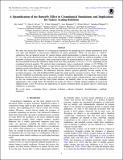A Quantification of the Butterfly Effect in Cosmological Simulations and Implications for Galaxy Scaling Relations
Author(s)
Genel, Shy; Bryan, Greg L.; Springel, Volker; Hernquist, Lars; Nelson, Dylan; Pillepich, Annalisa; Weinberger, Rainer; Pakmor, Rüdiger; Marinacci, Federico; Vogelsberger, Mark; ... Show more Show less
DownloadPublished version (2.779Mb)
Terms of use
Metadata
Show full item recordAbstract
We study the chaotic-like behavior of cosmological simulations by quantifying how minute perturbations grow over time and manifest as macroscopic differences in galaxy properties. When we run pairs of "shadow" simulations that are identical except for random minute initial displacements to particle positions (e.g., of order 10 -7 pc), the results diverge from each other at the individual galaxy level (while the statistical properties of the ensemble of galaxies are unchanged). After cosmological times, the global properties of pairs of "shadow" galaxies that are matched between the simulations differ from each other, generally at a level of ∼2-25%, depending on the considered physical quantity. We perform these experiments using cosmological volumes of (25-50 Mpc h)3 evolved either purely with dark matter, or with baryons and star formation but no feedback, or else using the full feedback model of the IllustrisTNG project. The runs cover four resolution levels spanning a factor of 512 in mass. We find that, without feedback, the differences between shadow galaxies generally become smaller as the resolution increases-but with the IllustrisTNG model, the results mostly converge toward a "floor. " This hints at the role of feedback in setting the chaotic properties of galaxy formation. Importantly, we compare the macroscopic differences between shadow galaxies to the overall scatter in various galaxy scaling relations, and conclude that, for the star formation-mass and the Tully-Fisher relations, the butterfly effect in our simulations contributes significantly to the overall scatter. We find that our results are robust to whether random numbers are used in the subgrid models or not. We discuss the implications for galaxy formation theory in general and for cosmological simulations in particular.
Date issued
2019-01Department
Massachusetts Institute of Technology. Department of Physics; MIT Kavli Institute for Astrophysics and Space ResearchJournal
Astrophysical Journal
Publisher
American Astronomical Society
Citation
Genel, Shy et al. "A Quantification of the Butterfly Effect in Cosmological Simulations and Implications for Galaxy Scaling Relations." Astrophysical Journal 871, 1 (January 2019): 21 © 2019 The American Astronomical Society
Version: Final published version
ISSN
1538-4357